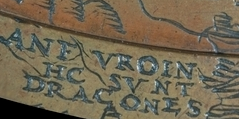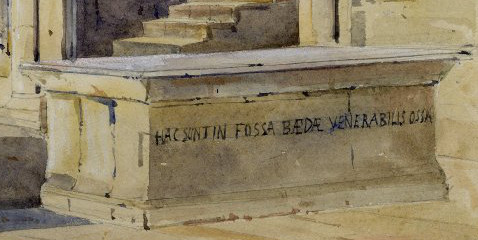Dactylic hexameter is a form of meter or rhythmic scheme frequently used in Ancient Greek and Latin poetry. The scheme of the hexameter is usually as follows :
The elegiac couplet is a poetic form used by Greek lyric poets for a variety of themes usually of smaller scale than the epic. Roman poets, particularly Catullus, Propertius, Tibullus, and Ovid, adopted the same form in Latin many years later. As with the English heroic couplet, each pair of lines usually makes sense on its own, while forming part of a larger work.
In poetry, a hendecasyllable is a line of eleven syllables. The term may refer to several different poetic meters, the older of which are quantitative and used chiefly in classical poetry, and the newer of which are syllabic or accentual-syllabic and used in medieval and modern poetry.
In poetry, metre or meter is the basic rhythmic structure of a verse or lines in verse. Many traditional verse forms prescribe a specific verse metre, or a certain set of metres alternating in a particular order. The study and the actual use of metres and forms of versification are both known as prosody.

Latin is a heavily inflected language with largely free word order. Nouns are inflected for number and case; pronouns and adjectives are inflected for number, case, and gender; and verbs are inflected for person, number, tense, aspect, voice, and mood. The inflections are often changes in the ending of a word, but can be more complicated, especially with verbs.

In publishing and graphic design, Lorem ipsum is a placeholder text commonly used to demonstrate the visual form of a document or a typeface without relying on meaningful content. Lorem ipsum may be used as a placeholder before the final copy is available. It is also used to temporarily replace text in a process called greeking, which allows designers to consider the form of a webpage or publication, without the meaning of the text influencing the design.
Iambic pentameter is a type of metric line used in traditional English poetry and verse drama. The term describes the rhythm, or meter, established by the words in each line. Rhythm is measured in small groups of syllables called "feet". "Iambic" indicates that the type of foot used is the iamb, which in English is an unstressed syllable followed by a stressed syllable. "Pentameter" indicates that each line has five "feet".

"Here be dragons" means dangerous or unexplored territories, in imitation of a medieval practice of putting illustrations of dragons, sea monsters and other mythological creatures on uncharted areas of maps where potential dangers were thought to exist.
De contemptu mundi is the most well-known work of Bernard of Cluny. It is a 3,000 verse poem of stinging satire directed against the secular and religious failings he observed in the world around him. He spares no one; priests, nuns, bishops, monks, and even Rome itself are mercilessly scourged for their shortcomings. For this reason it was first printed by Matthias Flacius in Varia poemata de corrupto ecclesiae statu as one of his testes veritatis, or witnesses of the deep-seated corruption of medieval society and of the Church, and was often reprinted by Protestants in the course of the seventeenth and eighteenth centuries.

This glossary of literary terms is a list of definitions of terms and concepts used in the discussion, classification, analysis, and criticism of all types of literature, such as poetry, novels, and picture books, as well as of grammar, syntax, and language techniques. For a more complete glossary of terms relating to poetry in particular, see Glossary of poetry terms.
The golden line is a type of Latin dactylic hexameter frequently mentioned in Latin classrooms and in contemporary scholarship about Latin poetry, but which apparently began as a verse-composition exercise in schools in early modern Britain.

A number of biographies of Muhammad were written in Latin during the 9th to 13th centuries.
The Celtic mass is the liturgy of the Christian office of the Mass as it was celebrated within Celtic Rite of Celtic Christianity in the Early Middle Ages.
Latin prosody is the study of Latin poetry and its laws of meter. The following article provides an overview of those laws as practised by Latin poets in the late Roman Republic and early Roman Empire, with verses by Catullus, Horace, Virgil and Ovid as models. Except for the early Saturnian poetry, which may have been accentual, Latin poets borrowed all their verse forms from the Greeks, despite significant differences between the two languages.

Prophetiae Sibyllarum are a series of twelve motets by the Franco-Flemish composer Orlando di Lasso. The works are known for their extremely chromatic idiom.
Latin syntax is the part of Latin grammar that covers such matters as word order, the use of cases, tenses and moods, and the construction of simple and compound sentences, also known as periods.
Roman comedy is mainly represented by two playwrights, Plautus and Terence. The works of other Latin playwrights such as Livius Andronicus, Naevius, Ennius, and Caecilius Statius are now lost except for a few lines quoted in other authors. 20 plays of Plautus survive complete, and 6 of Terence.
The Latin rhythmic hexameter or accentual hexameter is a kind of Latin dactylic hexameter which arose in the Middle Ages alongside the metrical kind. The rhythmic hexameter did not scan correctly according to the rules of classical prosody; instead it imitated the approximate sound of a typical metrical hexameter by having roughly the same number of syllables and putting word accents in approximately the same places in the line.






